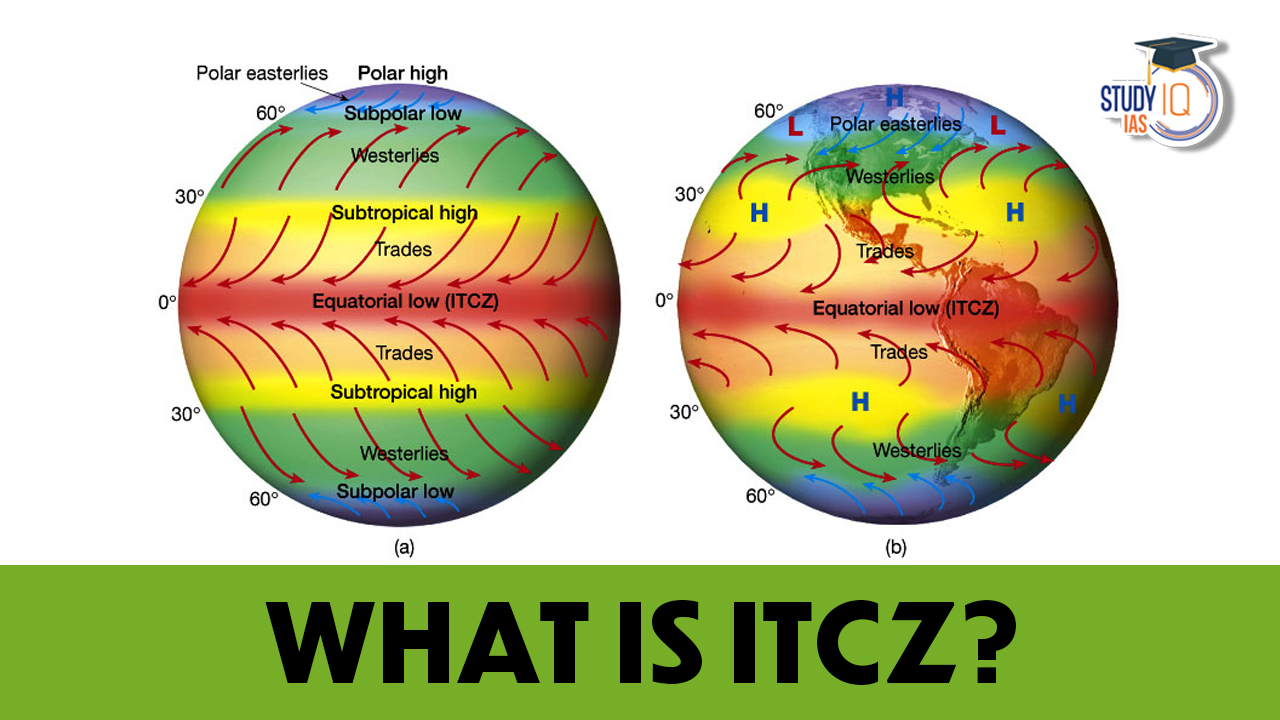Table of Contents
What is ITCZ?
Where the northeast trade winds from the Northern Hemisphere meet the southeast trade winds from the Southern Hemisphere, the ITCZ or Inter-Tropical Convergence Zone is a belt of low pressure that is situated close to the equator. As a result of the winds converging, warm, moist air rises, causing clouds to develop and precipitation to fall.
ITCZ is an important part of Geography which is an important subject in UPSC Syllabus. Students can also go for UPSC Mock Test to get more accuracy in their preparations.
ITCZ and Its Feature
Nearly parallel to the equatorial zone around the Earth is where the Inter-Tropical Convergence Zone is situated. The term “equatorial regions” refers to areas that are close to the equator and are frequently distinguished by extremely high temperatures and high humidity. The equatorial region’s warm water heats the air in the ITCZ, which causes it to become buoyant and humid.
It is in this area that the easterlies from the Northern and Southern hemispheres converge. When the trade winds come together, it causes thunderstorms and heavy rain at a height of 10 miles and a speed of 16 km. The Inter-Tropical Convergence Zone is unstable and changes position in response to the Sun’s position.
ITCZ tends to migrate from North to South and from water to land since the water takes longer to warm up than the land. The ITCZ plays a significant role in regulating seasonal fluctuations in tropical areas. ITCZ is characterized by doldrums, heavy cloudiness, calmness in the surface air, and other conditions that make it a highly unpredictable zone.
ITCZ Shifting Nature?
The Inter-Tropical Convergence Zone (ITCZ) is crucial to maintaining a stable climate since it determines how wet and dry the seasons are in tropical areas and those close to the equator.
The aforementioned zone shows poleward migration, which is more pronounced over land than it is over water because water takes a lot longer to warm up than land does. Additionally, the Northern Hemisphere exhibits the ITCZ’s movement more clearly than the Southern Hemisphere. In Eastern Asia, ITCZ propagation can extend up to 30 degrees north of the equator.
Over the Pacific and Atlantic oceans in July and August, the ITCZ is observed to propagate 5 to 15 degrees to the north of the Equator. The ITCZ exhibits a southern expansion in January in a number of nations, including South Africa, South America, and Australia. Tropical cyclones arise as the ITCZ moves towards subtropical and tropical latitudes during the summer because of increased Coriolis force.
Importance of ITCZ
The aforementioned zone has grown in significance due to both its role in climate regulation and the distinctive characteristics that set it apart from other regions. Additionally, the ITCZ is essential to the global circulation system. It is a system that describes how air and storms move over the surface of the Earth, which is largely dependent on the direction and speed of the planet’s rotation.
Due to its unpredictable weather, the area has grown significantly in prominence and was given the moniker “doldrums” by sailors. It is thought to be a nautical phrase coined by sailors since, in earlier times, ships would become stranded in the Inter-Tropical Convergence Zone because of the lack of wind creating windless waters. Due to the possibility of turbulence, wind shear, icing, lightning, and other hazards, this area might be hazardous for the safety of the aircraft as well.
ITCZ UPSC
Along the Earth’s equator, the Inter-Tropical Convergence Zone is a prominent area that greatly influences the dry and rainy seasons in the equatorial areas. Ancient sailors referred to the described area as the “doldrums” because of the weather’s unpredictability. These locations’ names originated from the months-long ship strikes caused by the windless waters there. This area frequently experiences cloudy skies, torrential downpours, thunderstorms, and other severe weather, making it dangerous for aeroplanes as well. The ITCZ is significant in climate regulation due to its cyclical nature. Students can read all the details related to UPSC by visiting the official website of StudyIQ UPSC Online Coaching.


 Story of Meera Bai and Her Devotion For ...
Story of Meera Bai and Her Devotion For ...
 Desert Climate, Distribution, Climatic C...
Desert Climate, Distribution, Climatic C...
 Deserts of India Map, Features of Thar D...
Deserts of India Map, Features of Thar D...





















